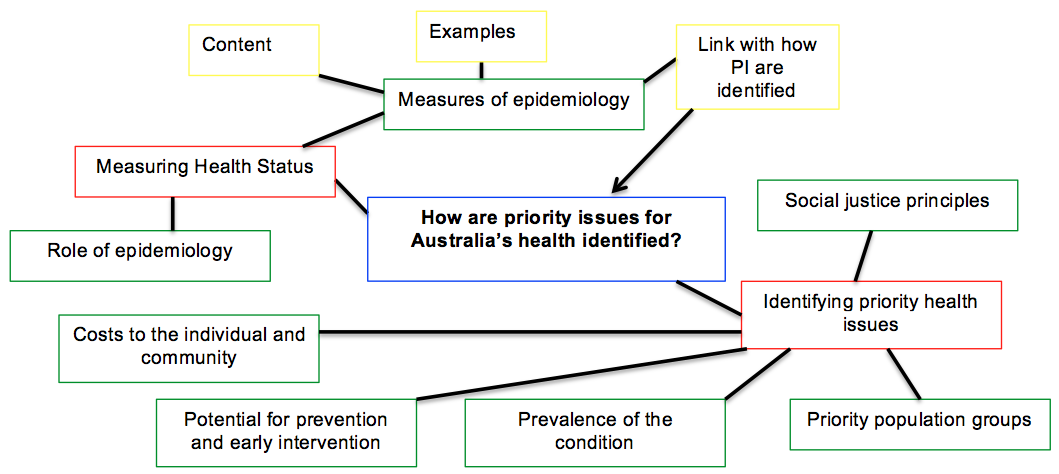Mind maps are a great study tool and come highly recommended for HSC PDHPE. I used them throughout my HSC and also through all my University study (8 years). I find them especially helpful when preparing for exams. Mind maps allow frequent revision and help to make connections between information. But the greatest benefit of mind maps is that they can be used to provide a structure or plan for any exam questions that may be asked. So, how do you make them and how should you use them?
How should you make Mind Maps?
Mind maps are all about connections and providing structure to what you are learning. They should not try and cover an entire topic or module at once. Instead, they should cover one (1) critical question.
- The critical question goes in the middle, and each dot point goes around the critical question.
- From here each dot point has its dashes around it.
- The final step is to place the content key terms, 2 examples and a link statement connecting the content with the critical question (this is very important for those seeking band 6).
- Add connecting lines and write along the line how or why they connect
- Use colour
Remember that your brain likes colour, so it is important to colour code your mind map, as this will help you remember your HSC PDHPE content. Eg)
Including separate coloured lines to connect related ideas is very important. This is particularly the case with content like How does training affect performance? Where the learn to says you need to:
“Examine the relationship between the principles of training, physiological adaptations and improved performance”
So add connecting lines and write along the line how or why they connect.
Follow the structure for measures of epidemiology and add content key terms, examples and linking statements around each of your dash points. This will provide the SEAL structure to help you write an extended response exam answer.
How to use Mind Maps
The secret to benefitting from mind maps in HSC PDHPE is to use them as frequently as possible. Mind maps are great for putting in that extra bit of study when you are not doing anything else anyway. Print multiple copies and put them up around your room, in the kitchen, cover your bathroom and toilet doors. Read them as you brush your teeth, do your business, or are getting changed. Read through your mind maps before you go to sleep. You could even put them up on your roof and read them as you lie in bed in the morning. Read them as frequently as possible, even while you are doing something else.
You can also use them to test yourself. Read the critical question and then see if you can recall all the information in the min map without looking at the rest of it. Them read through it and check to see if you got it right. Remember the mind map only has key content terms; you should try to remember all the content linked with these terms, not just the terms themselves.
When using your mind maps it is important to say things out loud when possible (not while brushing teeth) as this helps retention of the content. You should pay attention to your connecting lines if you have any.
You can also vary things up and test yourself by rewriting your mind maps from scratch. This will become very helpful in exams when you get asked to write a six (6) or twelve (12) mark answer. Quickly drawing your mind map will provide the information and structure needed for the question.
One of the benefits of the mind map system is that it helps you to learn your syllabus. This is a key thing in HSC PDHPE, where the question often has a syllabus key term in it and you are required to remember the rest of the syllabus that relates to this key term. Eventually, you could even test yourself by getting a massive piece of butchers paper and writing Core 1, or even PDHPE in the middle and see if you can get everything in the right place.
Remember, testing your knowledge is the best way to learn and the best way to check you have learnt the content with their examples.






